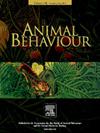Predicting success of conservation translocations: prerelease screening tools for a threatened marsupial
IF 2.1
2区 生物学
Q2 BEHAVIORAL SCIENCES
引用次数: 0
Abstract
Individual animals differ in their responses to environmental challenges. Identifying these differences before animals are translocated could be a useful tool in improving postrelease success. For most species, however, uncertainty persists around which behaviours contribute to postrelease success. Greater bilbies, Macrotis lagotis, are a threatened species, for which detailed behavioural studies in situ are rare. We tested bilbies prior to their release to a fenced safe haven to examine whether (1) bilby response to a known threat (that is, human observer) and novelty (that is, novel scent) was individually different and repeatable, or alternatively plastic, and (2) if any behaviours were related to bilby fitness (breeding success and survival) postrelease. We found that several behaviours measured during trapping (exposure to a known threat) were individually variable and repeatable and that males that were less responsive (lower respiratory rate) during handling had greater breeding success (that is, the number of offspring sired relative to the opportunity to breed). Contrastingly, individual differences in bilby response to novel scents were not repeatable, but we did, however, find sex-specific responses in this context. Males took less time to initiate touch with the novel-scented object and touched the object more times than females, suggesting that males are less neophobic. Plasticity rather than personality predicted female postrelease fitness. Females that were increasingly cautious of novelty had greater relative breeding success. Our study is the first to confirm repeatable and plastic behaviours in bilbies, develop a standardized test for prerelease screening of behaviours, and examine the fitness consequences of these behaviours. We encourage the use of the ‘trap test’ as a simple and practical way to screen bilbies for future conservation translocations. We also recommend further testing in environments where the risk of establishment failure may be higher (that is, invasive predators present) and where the fitness consequences may be more profound and thus detectable.
预测保护易位的成功:濒危有袋动物的预释放筛选工具
动物个体对环境挑战的反应不同。在动物易位之前识别这些差异可能是提高放生后成功率的有用工具。然而,对于大多数物种来说,关于哪些行为有助于释放后成功的不确定性仍然存在。大袋狸(Macrotis lagotis)是一种濒危物种,对其详细的行为研究很少。我们在兔耳袋狸被释放到围栏安全避难所之前对它们进行了测试,以检查:(1)兔耳袋狸对已知威胁(即人类观察者)和新颖性(即新颖气味)的反应是否具有个体差异和可重复性,或者具有可塑性,以及(2)释放后是否有任何行为与兔耳袋狸的适应性(繁殖成功和生存)有关。我们发现,在诱捕(暴露于已知威胁)期间测量的几种行为是单独可变的和可重复的,并且在处理过程中反应较弱(呼吸频率较低)的雄性繁殖成功率更高(即,相对于繁殖机会的后代数量)。相比之下,兔耳袋狸对新气味的反应的个体差异是不可重复的,但我们确实在这种情况下发现了性别特异性反应。与女性相比,男性接触新奇气味物品的时间更短,接触的次数也更多,这表明男性对新事物的恐惧程度更低。预测女性释放后适应性的不是个性,而是可塑性。对新奇事物越来越谨慎的雌性相对来说繁殖成功率更高。我们的研究首次证实了兔耳袋狸的可重复和可塑行为,开发了一种标准化的释放前行为筛选测试,并检查了这些行为对健康的影响。我们鼓励使用“陷阱测试”作为一种简单实用的方法来筛选兔耳袋狸,以便将来进行保护易位。我们还建议在建立失败的风险可能更高(即存在入侵掠食者)的环境中进行进一步的测试,在这些环境中,适应性后果可能更深刻,因此可以检测到。
本文章由计算机程序翻译,如有差异,请以英文原文为准。
求助全文
约1分钟内获得全文
求助全文
来源期刊

Animal Behaviour
生物-动物学
CiteScore
4.60
自引率
8.00%
发文量
236
审稿时长
10.2 weeks
期刊介绍:
Growing interest in behavioural biology and the international reputation of Animal Behaviour prompted an expansion to monthly publication in 1989. Animal Behaviour continues to be the journal of choice for biologists, ethologists, psychologists, physiologists, and veterinarians with an interest in the subject.
 求助内容:
求助内容: 应助结果提醒方式:
应助结果提醒方式:


